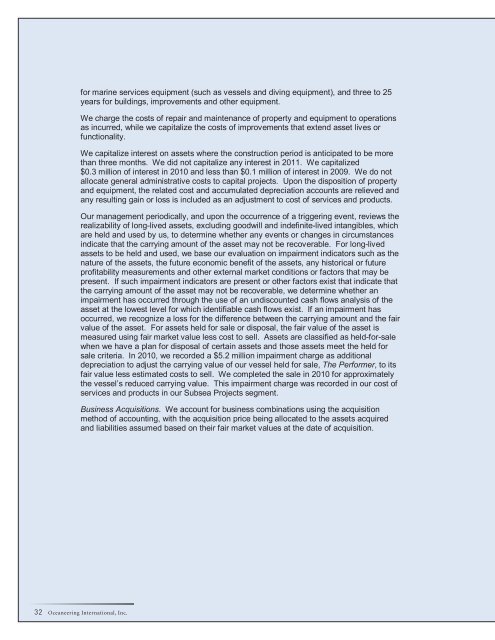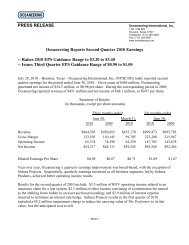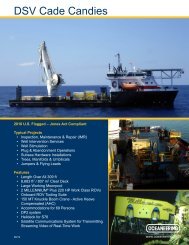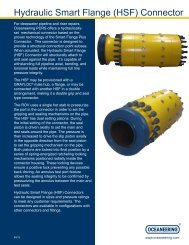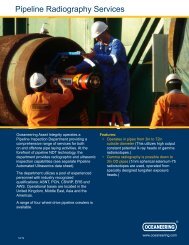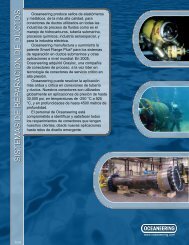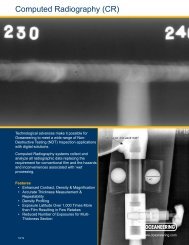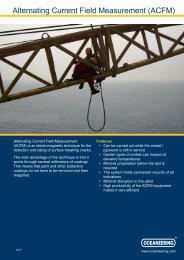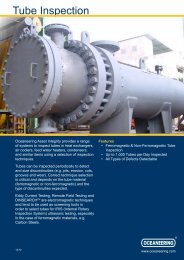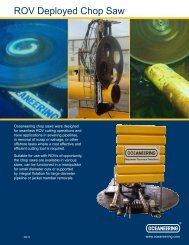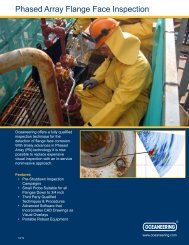<strong>for</strong> marine services equipment (such as vessels and diving equipment), and three to 25years <strong>for</strong> buildings, improvements and other equipment.We charge the costs of repair and maintenance of property and equipment to operationsas incurred, while we capitalize the costs of improvements that extend asset lives orfunctionality.We capitalize interest on assets where the construction period is anticipated to be morethan three months. We did not capitalize any interest in 2011. We capitalized$0.3 million of interest in 2010 and less than $0.1 million of interest in 2009. We do notallocate general administrative costs to capital projects. Upon the disposition of propertyand equipment, the related cost and accumulated depreciation accounts are relieved andany resulting gain or loss is included as an adjustment to cost of services and products.Our management periodically, and upon the occurrence of a triggering event, reviews therealizability of long-lived assets, excluding goodwill and indefinite-lived intangibles, whichare held and used by us, to determine whether any events or changes in circumstancesindicate that the carrying amount of the asset may not be recoverable. For long-livedassets to be held and used, we base our evaluation on impairment indicators such as thenature of the assets, the future economic benefit of the assets, any historical or futureprofitability measurements and other external market conditions or factors that may bepresent. If such impairment indicators are present or other factors exist that indicate thatthe carrying amount of the asset may not be recoverable, we determine whether animpairment has occurred through the use of an undiscounted cash flows analysis of theasset at the lowest level <strong>for</strong> which identifiable cash flows exist. If an impairment hasoccurred, we recognize a loss <strong>for</strong> the difference between the carrying amount and the fairvalue of the asset. For assets held <strong>for</strong> sale or disposal, the fair value of the asset ismeasured using fair market value less cost to sell. Assets are classified as held-<strong>for</strong>-salewhen we have a plan <strong>for</strong> disposal of certain assets and those assets meet the held <strong>for</strong>sale criteria. In 2010, we recorded a $5.2 million impairment charge as additionaldepreciation to adjust the carrying value of our vessel held <strong>for</strong> sale, The Per<strong>for</strong>mer, to itsfair value less estimated costs to sell. We completed the sale in 2010 <strong>for</strong> approximatelythe vessel’s reduced carrying value. This impairment charge was recorded in our cost ofservices and products in our Subsea Projects segment.Business Acquisitions. We account <strong>for</strong> business combinations using the acquisitionmethod of accounting, with the acquisition price being allocated to the assets acquiredand liabilities assumed based on their fair market values at the date of acquisition.32 <strong>Oceaneering</strong> International, Inc.
The following table presents the cost (net of cash acquired) and the amounts ofassociated goodwill, other intangible assets, and other assets net of liabilities assumed<strong>for</strong> the business acquisitions we made in 2011:(in thousands) Cost GoodwillOtherIntangibleAssetsOther,netNorse Cutting and Abandonment AS $ 50,296 $ 17,777 $ 15,945 $ 16,574AGR Field Operations Holdings AS 220,011 165,201 32,067 22,743Mechanica AS 17,214 8,877 5,360 2,977Other 4,096 1,959 — 2,137Total Business Acquisitions $ 291,617 $ 193,814 $ 53,372 $ 44,431On March 31, 2011, we purchased Norse Cutting and Abandonment AS ("NCA"), aNorwegian oilfield technology company that specializes in providing subsea toolingservices used in the plugging, abandonment and decommissioning of offshore oil andgas production plat<strong>for</strong>ms and subsea wellheads. In addition, NCA per<strong>for</strong>ms specializedmaintenance and repair services on production plat<strong>for</strong>ms in the North Sea. NCA'sbusiness is split approximately evenly between the North Sea and the U.S. Gulf ofMexico. The acquisition included a small, non-strategic business operation we intendedto sell when we purchased NCA. During 2011, we sold that operation, making the netacquisition price of the retained NCA operations $50 million. We have accounted <strong>for</strong> thisnet acquisition by allocating the purchase price to the assets acquired and liabilitiesassumed based on their estimated fair values at the date of acquisition. Our goodwill, allnondeductible <strong>for</strong> income tax purposes, associated with the acquisition was $18 million,and other intangible assets were $16 million. This purchase price allocation ispreliminary and based on in<strong>for</strong>mation currently available to us, and is subject to changewhen we obtain final asset and liability valuations. The results of operations of NCA areincluded in our consolidated statements of income from the date of acquisition.On December 20, 2011, we purchased AGR Field Operations Holdings AS andsubsidiaries (collectively, "AGR FO"), which we believe is Norway's largest asset integritymanagement service provider on offshore production plat<strong>for</strong>ms, onshore facilities, andpipelines. AGR FO employs subsea technology to per<strong>for</strong>m internal and externalinspections of subsea hardware. AGR FO also has a substantial operating presence inAustralia where it operates and maintains offshore and onshore oil and gas productionfacilities <strong>for</strong> customers and provides subsea engineering services and operates anoffshore logistics supply base. We incurred, and charged to expense, approximately$2 million of transaction costs associated with this acquisition.We have accounted <strong>for</strong> this acquisition by allocating the purchase price to the assetsacquired and liabilities assumed based on their estimated fair values at the date ofacquisition. Our goodwill, all nondeductible <strong>for</strong> income tax purposes, associated with theacquisition was $165 million, and other intangible assets were $32 million. This purchaseprice allocation is preliminary and based on in<strong>for</strong>mation currently available to us, and issubject to change when we obtain final asset and liability valuations. As we acquiredAGR FO late in December 2011, its results of operations are included in our consolidatedstatements of income from the date of acquisition, but the 2011 results were not material.Generally, AGR FO's Norwegian assets and operations are in our Asset Integrity2011 Annual Report 33
- Page 3 and 4: Financial Highlights($ in thousands
- Page 5 and 6: In December we secured a three-year
- Page 7: 2011 Financial SectionOceaneering I
- Page 10 and 11: Oceaneering Common StockOur common
- Page 12 and 13: Management's Discussion and Analysi
- Page 14 and 15: Critical Accounting Policies and Es
- Page 16 and 17: We establish valuation allowances t
- Page 18 and 19: In 2009, we used $162 million in in
- Page 20 and 21: For 2011, our ROV revenue and opera
- Page 22 and 23: We earn equity income from our 50%
- Page 24 and 25: Controls and ProceduresDisclosure C
- Page 26 and 27: In our opinion, Oceaneering Interna
- Page 28 and 29: OCEANEERING INTERNATIONAL, INC. AND
- Page 30 and 31: OCEANEERING INTERNATIONAL, INC. AND
- Page 32 and 33: OCEANEERING INTERNATIONAL, INC. AND
- Page 36 and 37: segment and its Australian assets a
- Page 38 and 39: Revenue in Excess of Amounts Billed
- Page 40 and 41: elationship and, if it is, the type
- Page 42 and 43: December 31,(in thousands) 2011 201
- Page 44 and 45: in entities or jurisdictions that h
- Page 46 and 47: 4. SELECTED BALANCE SHEET AND INCOM
- Page 48 and 49: On January 6, 2012, we entered into
- Page 50 and 51: Financial Instruments and Risk Conc
- Page 52 and 53: The table that follows presents Rev
- Page 54 and 55: The following table presents Assets
- Page 56 and 57: Geographic Operating AreasThe follo
- Page 58 and 59: equirements. The Compensation Commi
- Page 60 and 61: in 2011, 2010 and 2009 were subject
- Page 62 and 63: Forward-Looking StatementsAll state
- Page 64: Oceaneering International, Inc.1191


